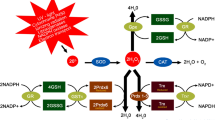Abstract
N ɛ-(carboxymethyl)lysine, an advanced glycation end product, is present in the human lens. The effects of CML formation on protein conformation and stability were studied using the recombinant γC-crystallin as a model. Conformational change was studied by spectroscopic measurements such as fluorescence and circular dichroism. Conformational stability was determined by unfolding with heat. The results indicated that no conformational change was observed due to CML formation, but conformational stability decreased. These observations can be explained in terms of the relatively stable structure of γ-crystallin, especially when compared with other crystallins. The lens nucleus is rich in γ-crystallin and its stable conformation can assist γ-crystallin sustained insults and remain soluble.
Similar content being viewed by others
REFERENCES
Ahmed, M. U., Brinkmann Frye, E., Degenhardt, T. P., Thorpe, S. R., and Baynes, J. W. (1997). Biochem.J. 324, 565–570.
Akhtar, N. J., Sun, T-X, and Liang, J. J. N. (1999). Curr.Eye Res. 18, 270–276.
Andley, U. P., Mathur, S., Griest, T. A., and Petrash, J. M. (1996). J.Biol.Chem. 271, 31973–31980.
Blundell, T., Lindley, P., Miller, L., Moss, D., Slingsby, C., Tickle, I., Turnell, B., and Wistow, G. (1981). Nature 289, 771–777.
Bova, M. P., Yaron, O., Huang, Q., Ding, L., Haley, D. A., Stewart, P. L., and Horwitz, J. (1999). Proc.Natl.Acad.Sci.USA 96, 6137–6142.
Clayton, R. C. (1985). In The Ocular Lens: Structure, Function, and Pathology (Maisel, H., ed.), Marcel Dekker, New York, pp. 61–92.
Cobb, B. A. and Petrash, J. M. (2000). Biochemistry 39, 15791–15798.
Cohen, M. P. (1996). In Diabetes and Protein Glycation,JC Press, Philadelphia, Pennsylvania, pp. 5–31.
Das, B. K., Sun, T. X., Akhtar, N. J., Chylack, Jr., L. T., and Liang, J. J. N. (1998). Invest.Ophthalmol.Vis.Sci. 39, 2058–2066.
Fu, L. and Liang, J. J. N. (2001). Mol.Vis. 7, 178–182.
Habeeb, A. F. S. A. (1966). Anal.Biochem. 14, 328–336.
Hammond, C. J., Snieder, H., Spector, T. D., and Gilbert, C. E. (2000). N.Engl.J.Med. 342, 1786–1790.
Harding, J. J. (1991). In Cataract: Biochemistry, Epidemiology and Pharmacology, Chap. 5, Chapman & Hall, London, pp. 195–217.
Harding, J. J. (1997). Curr.Opin.Ophthalmol. 8, 46–49.
Heiba, I. M., Elston, R. C., Klein, B. E., and Klein, R. (1993). Am.J.Med.Genet. 47, 1208–1214.
Heon, E., Priston, M., Schorderet, D. F., Billingsley, G. D., Girard, P. O., Lubsen, N., and Munier, F. L. (1999). Am.J.Hum.Genet. 65, 1261–1267.
Lampi, K. J., Ma, Z., Shih, M., Shearer, T. R., Smith, J. B., Smith, D. L., and David, L. L. (1997). J.Biol.Chem. 272, 2268–2275.
Liang, J. N. and Rossi, M. T. (1990). Exp.Eye Res. 50, 367–371.
Lyons, T. J., Silvestri, G., Dunn, J. A., Dyer, D. G., and Baynes, J. W. (1991). Diabetes 40, 1010–1015.
Mach, H., Middaugh, C. R., and Lewis, R. V. (1992). Anal.Biochem. 200, 74–80.
Mayr, E. M. Jaenicke, R., and Glockshuber, R. (1997). J.Mol.Biol. 269, 260–269.
Monnier, V. M. and Cerami, A. (1981). Science 211, 491–493.
Nagaraj, R. H. and Monnier, V. M. (1992). Biochim.Biophys.Acta 1116, 34–42.
Nagaraj, R. H., Sell, D. R., Prabhakaram, M., Ortwerth, B. J., and Monnier, V. M. (1991). Proc.Natl.Acad.Sci.USA 88, 10257–10261.
Pande, A., Pande, J., Asherie, N., Lomakin, A., Ogun, O., King, J. A., Lubsen, N. H., Walton, D., and Benedek, G. B. (2000). Proc. Natl.Acad.Sci.USA 97, 1993–1998.
Prabhakaram, M. and Ortwerth, B. J. (1992). Exp.Eye Res. 55, 451–459.
Reddy, S., Bichler, J., Wells-Knecht, K. J., Thorpe, S. R., Baynes, J. W. (1995). Biochemistry 34, 10872–10878.
Smith, R. S., Hawes, N. L. Chang, B., Roderick, T. H., Akeson, E. C., Heckenlively, J. R., Gong, X., Wang, X., and Davisson, M. T. (2000). Genomics 63, 314–320.
Stephan, D. A., Gillanders, E., Vanderveen, D., Freas-Lutz, D., Wistow, G., Baxevanis, A. D., Robbins, C. M., VanAuken, A., Quesenberry, M. I., Bailey-Wilson, J., Juo, S. H., Trent, J. M., Smith, L., and Brownstein, M. J. (1999). Proc.Natl.Acad.Sci. USA 96, 1008–1012.
Sun, T-X and Liang, J. J. N. (1998). J.Biol.Chem. 273, 286–290.
White, H. E., Driessen, H. P., Slingsby, C., Moss, D. S., and Lindley, P. F. (1989). J.Mol.Biol. 207, 217–235.
Author information
Authors and Affiliations
Corresponding author
Rights and permissions
About this article
Cite this article
Liang, J.JN., Fu, L. Conformational Study of Nɛ-(carboxymethyl)lysine Adducts of Recombinant γC-crystallin. J Protein Chem 20, 641–645 (2001). https://doi.org/10.1023/A:1013768319488
Published:
Issue Date:
DOI: https://doi.org/10.1023/A:1013768319488




